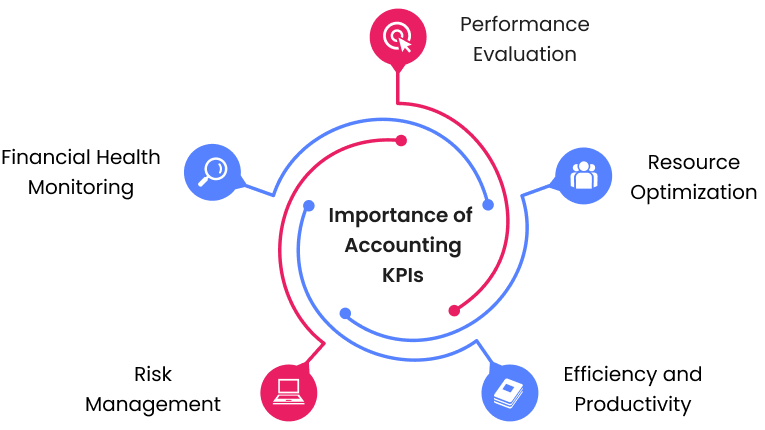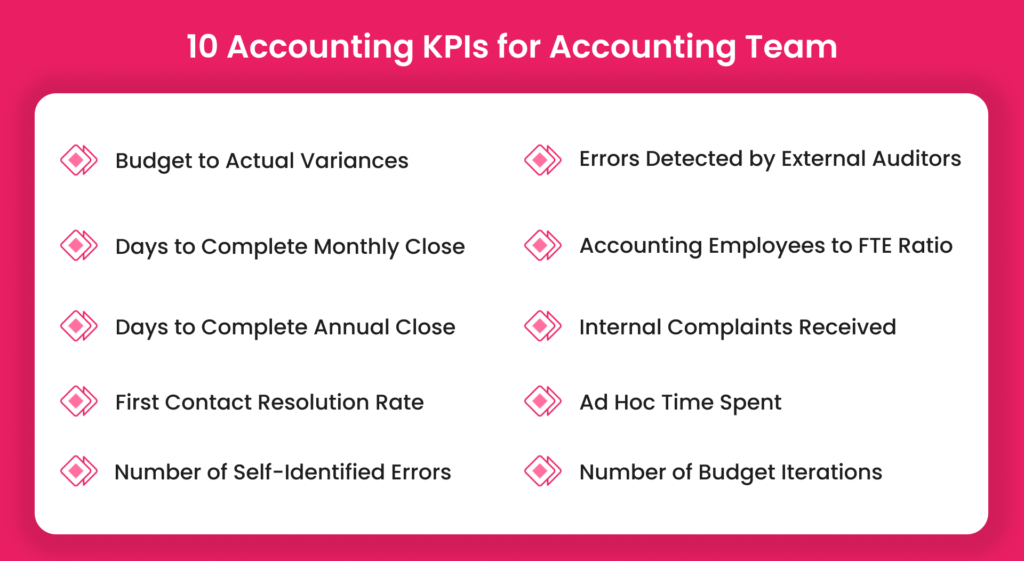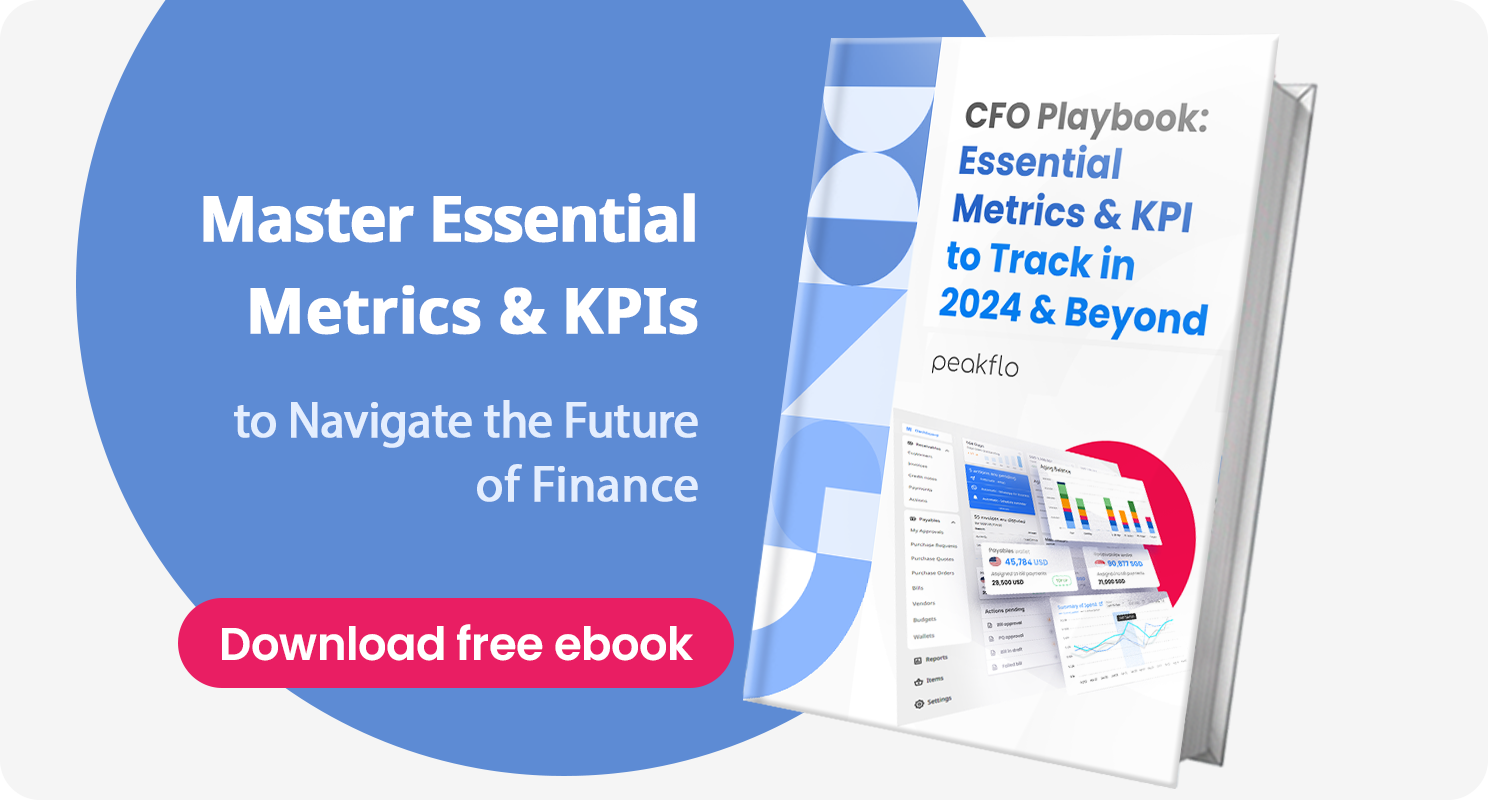For all accounting teams, accounting KPIs (Key Performance Indicators) are essential for driving financial success. By understanding, using, and tracking these metrics, they can get a clear picture of their financial health, make better decisions, and move toward sustainable growth.
In this blog, we will explore different accounting KPIs. We’ll discuss what they are, why they matter, and how they help organizations make informed decisions.
Understanding Accounting KPIs
Accounting KPIs are specific measures that help businesses evaluate how well their accounting and financial processes are working. These indicators give insights into different areas of financial management, allowing organizations to check the performance of their accounting functions, make smart decisions, and maintain financial health.
Accounting KPIs look at various aspects, such as budgeting, financial reporting, process efficiency, risk management, and overall department performance. They help businesses align their accounting practices with their goals, spot areas that need improvement, and track progress over time.
Some common accounting KPIs include how closely budgets match actual spending, how quickly financial records are closed, and how effective the accounting department is overall.
By regularly checking and analyzing these KPIs, businesses can understand their financial performance better, make informed decisions, and continually enhance their accounting processes.
Why Should You Monitor Key Performances
KPIs are important tools for measuring how well your accounting practice is doing in reaching its goals. These indicators are specific, measurable, and focus on both daily activities and long-term strategies. To be useful, KPIs should be easy to understand, clearly communicated, and realistic to achieve over time.
Not keeping an eye on KPIs can harm your practice. If you only check KPIs off a list without truly engaging with them, you lose the chance to make smart decisions that can boost your practice’s performance. KPIs give you insight into your practice’s financial health and help you make strategic choices.
By tracking KPIs, you can ensure your practice is moving in the right direction. They also help your staff understand what is expected of them and how they are doing. In short, KPIs are essential for making informed decisions about the future of your practice.
5 Reasons Why Accounting KPIs are Essential for Internal Accounting Departments
One big benefit of tracking financial KPIs is that it helps with future planning. For the accounting department, knowing how much money is coming in and going out is important for making smart choices.
Managing cash flow well is especially crucial. If sales go down and expenses go up, the business might need to cut costs to stay financially stable. On the other hand, if sales are increasing but expenses are also rising, it could be a good idea to invest more in marketing or hire more staff to take advantage of the growth.

Now, let’s take a look at why keeping track of the accounting KPIs is crucial.
- Performance Evaluation
Tracking key performance indicators (KPIs) helps measure how well a department is doing and how it contributes to the company’s overall goals. This process can show where improvements are needed and help recognize successful strategies and efforts. - Financial Health Monitoring
Keeping an eye on financial KPIs gives important insights into the organization’s financial health. It helps understand trends in revenue, profitability, cash flow, and overall stability. This information is essential for making smart decisions that ensure the organization’s long-term success. - Efficiency and Productivity
KPIs related to accounting can show how efficiently and productively the finance department is working. By measuring things like how long it takes to finish financial tasks, the accuracy of reports, and how resources are used, organizations can find areas to improve and make processes more efficient. - Resource Optimization
Analyzing financial KPIs can help organizations find ways to save costs. This might mean cutting unnecessary expenses, better allocating resources, or renegotiating contracts with suppliers. Optimizing resources based on these insights can lead to savings and increased profits. - Risk Management
Monitoring KPIs related to debt, like the debt-to-equity ratio or interest coverage ratio, helps manage financial risks. By keeping track of these metrics, organizations can spot potential risks early and take steps to reduce them. This could involve lowering debt levels, changing terms with creditors, or diversifying revenue sources to rely less on debt financing.
10 Accounting KPIs Every Accounting Team Should Track

Budget to Actual Variances
Measures the deviation between actual and budgeted costs.
Why it Matters: High variances indicate potential budgeting discrepancies or challenges in controlling expenditures, helping to refine future budgets and improve financial planning.
Days to Complete Monthly Close
Indicates the efficiency of closing the books at the end of each month.
Why it Matters: Prolonged periods can lead to delayed financial reporting, impacting decision-making. Efficient monthly closings ensure timely and accurate financial information.
Days to Complete Annual Close
Measures the speed of closing year-end books.
Why it Matters: Delays in the annual close can compromise the quality of annual reports. Timely closings facilitate accurate financial statements and compliance.
First Contact Resolution Rate (FCRR)
Measures the proportion of requests solved upon initial contact.
Why it Matters: A high FCRR indicates effective service levels, reducing the need for prolonged issue resolution. Enhances efficiency and customer satisfaction.
Number of Self-Identified Errors
Tracks errors identified through internal audit reports.
Why it Matters: Increasing numbers may signal more errors or an effective audit process. Careful interpretation guides improvements in the audit process.
Errors Detected by External Auditors
Records errors detected by external auditors not caught internally.
Why it Matters: Indicates the effectiveness of internal controls. A rising trend may signify shortcomings in internal audit processes.
Accounting Employees to Full-Time Employees (FTE) Ratio
Compares the size of the accounting department to the entire company.
Why it Matters: A low ratio signifies efficient cost management. However, it’s crucial to balance with other KPIs to ensure overall departmental effectiveness.
Internal Complaints Received
Tracks complaints from other business areas.
Why it Matters: Decreasing complaints signals successful process and policy changes, boosting customer satisfaction and reducing staff time spent on issue resolution.
Ad Hoc Time Spent
Measures time spent on tasks outside standard operational work.
Why it Matters: Excessive time on ad hoc tasks may indicate gaps in standard processes. Monitoring ensures effectiveness and addresses stakeholder needs.
Number of Budget Iterations
Records the frequency of budget revisions in a year.
Why it Matters: Reflects the efficiency of the budgeting process. Automation reduces errors, while external factors must be considered for accurate analysis and improvements.
A Way Forward
The need for automation has become crucial, especially for tracking important Accounting KPIs and keeping them healthy. Financial processes require accuracy, efficiency, and real-time insights to be successful. This is where automation plays a key role in maintaining the strength of these important KPIs.
To effectively manage KPIs like Budget to Actual Variances, the time it takes to complete monthly and annual closes, or the First Contact Resolution Rate, a smooth approach is necessary. Automation helps reduce errors and speeds up the monitoring and improvement of these KPIs.
This is where Peakflo’s AR and AP Automation come into play. By using advanced automation technology, Peakflo changes traditional accounting workflows to make them more efficient. This not only helps meet compliance and accuracy standards but also improves overall financial performance. Peakflo optimizes budgeting and speeds up financial closings, helping you achieve and exceed your accounting goals.
FAQ
What is a KPI for account reconciliation?
A KPI for account reconciliation is a measurable metric used to evaluate the effectiveness of the reconciliation process. It helps in assessing whether the process is meeting its objectives and identifies areas for improvement.
What is a KPI in the balance sheet?
A KPI in the balance sheet refers to important relationships among specific elements of the balance sheet that are crucial for monitoring the overall financial condition of a firm. These metrics, derived from balance sheet components, are industry-standard and provide valuable insights into the financial health of the organization.
What is a KPI in the audit?
A KPI in audit refers to a quantifiable metric used to assess the performance and effectiveness of the auditing process. It helps in evaluating the quality and efficiency of audit procedures and outcomes.
What is a KRA in accounting?
A Key Result Area (KRA) in accounting is a defined objective that is crucial to the performance of an individual employee, a department, or an organization. It helps to focus efforts on important outcomes.
How to Create Effective Key Result Areas?
Creating effective KRAs involves identifying objectives that are essential for success and aligning them with organizational goals. This ensures that efforts are directed towards achieving the most important outcomes.










![Why AI Sales Calls Are Making Good Sales Reps Even Better [2025 Guide] ai sales calls](https://blog.peakflo.co/wp-content/uploads/2025/09/65168cf6-3001-4733-8cbc-12d5684cf449-218x150.webp)



































